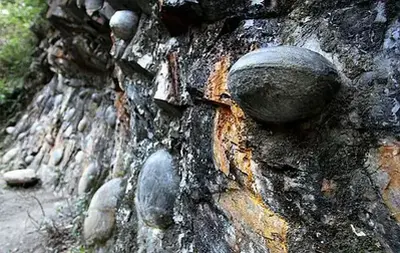History
Mysterious Myths About The Deepest Lake In The World: The Abode Of Dragons Guarding the Gold Store
Revolving around the world's deepest lake Baikal, there are always mysterious legends, such as the story of the fierce dragon, the gold vault of the Russian Empire and the tunnel leading to the eternal land.
Lake Baikal in Siberia in Russia is the oldest and deepest lake on our planet. For centuries, locals have regarded Baikal as a sacred place and passed on mysterious stories to future generations.
Fierce Dragon

Tourists walk on the frozen lake Baikal. Photo: Getty Images
Similar to Loch Ness in Scotland, Baikal also attached a “monster” of his own Nessie and it is a scary story indeed. Legend has it that a water dragon resides in Mukhorsky Bay, the warmest part of the lake, and regularly drags fishermen underwater. Some people think it resembles a giant sturgeon with an ugly face.
Many claim it is a lizard monster with claws and spikes running down its back, while others believe the monster looks like an ancient crocodile. Several centuries ago, indigenous people still sacrificed furs, jewelry and food, even blood, to keep the monsters from getting angry.

Illustration
In fact, in the 1980s, Soviet researchers detected a moving object, about 30 meters long in the bed of Lake Baikal with an echolocation device, but they were not able to identify it. is what. Russian and foreign monster hunters still have the answer to this mystery.
Gold vault of the Russian Empire

The Mir 2 submersible prepares to explore the lake Baikal. Photo: TASS
One of the great unsolved historical mysteries is the disappearance of the gold treasures of the Russian Empire after 1917. At that time, the country fell into civil war between supporters of the tsarist regime (White Guards). and supporters of the new regime (Red Army). Gold reserves were moved from the center of the capital as far as Siberia.
When found in 1919, it turned out that many of the crates had been swapped out for bricks. About 180 tons of gold have disappeared. Some believe that the gold vault of the Russian Empire sank under the deepest lake in the world, when the train carrying gold crashed on the Circum – Baikal railway.
Many times, the Mir submersible, during its exploration of the bottom of Lake Baikal, has found traces of centuries-old boxes and even glittering gold bars on them. However, these artifacts were never recovered due to the constantly shifting lake bottom.
River Angara

The Shaman Rock is located in the upper reaches of the Angara River. Photo: Sputnik
This is perhaps the most popular and romantic legend about Baikal. A total of about three hundred rivers and streams flow into Lake Baikal, but the only river that flows out is the Angara. It is one of the main rivers of Siberia and in ancient tales, Angara is considered the “daughter” of Baikal.
The people of Siberia liken Baikal to a wealthy earl who collects taxes from the surrounding lands, and his daughter Angara is the one who reimburses them all. She owns a necklace and hides it from anyone because she wants to save it for her future husband. Later, Baikal announced his decision to marry his daughter to all the knights in the vicinity. The father chose a young man named Irkut, although the daughter fell in love with the knight Yenisei. But her father’s words could not be violated, so he locked her up. Finally, on the eve of the wedding, Angara ran away from home, taking the necklace with her.
At the place where she met Irkut, now the city of Irkutsk, she tore off the necklace and threw the pearls to the people. And the place where she met her lover Yenisei, is where the Angara River flows into the Yenisei River. Legend has it that the girl Angara never returned, causing her father to miss her. He cried until his last breath and his tears turned into Lake Baikal. And Angara became the only river flowing out of Baikal, like a girl running away to find her lover.
Another world

Baikal is the deepest lake in the world and the people of Siberia have known this since before official scientific conclusions were made. Ancient stories tell that at the bottom of the lake is a bottomless abyss that leads to a vast ocean or another world. At the top of this abyss there is a strong whirlpool, which sweeps passing ships into another dimension.
The first time it was possible to calculate the depth of the lake was in the 1930s and then updated it continuously. It turns out that the average depth of Lake Baikal is 740 meters, but at the bottom there are countless cracks, especially one as deep as 1642 meters, which is said to be the “bottomless abyss” in legend. However, it is merely a tectonic fault point.
The name of Lake Baikal

Lake Baikal seen from space. Photo: NASA
Scientists are still debating the age of Lake Baikal. According to the main theory, this lake has existed for about 25-35 million years, but some experts estimate it to be between 150,000 and 8,000 years old. It is known that people began to live around this lake from the 2nd century BC. Although they come from different ethnic groups, they all call the lake by quite similar names.
“Bai” in many languages means “great, great”. In the Buryat language, “Baigal-dalai” means “large body of water, like the sea”. In the Yakut language, “baihal”, “baig’al” means “deep, large water”. Another legend holds that Lake Baikal was formed on a volcanic mountain and its name means “Standing on Fire”.
-

 History2h ago
History2h agoEven George Washington Was a Tyrant
-

 History18h ago
History18h agoWhat Democrats Can Learn from America’s First Black Voters
-

 History1d ago
History1d agoHow Celebrities Changed America’s Postpartum Depression Narrative
-

 History2d ago
History2d agoThe Woman Whose Crusade Gave Today’s Book-Banning Moms a Blueprint
-

 History6d ago
History6d agoHow Black Civil War Patriots Should Be Remembered This Veterans Day
-

 History1w ago
History1w agoThe Democratic Party Realignment That Empowered Trump
-

 History1w ago
History1w agoWhy People Should Stop Comparing the U.S. to Weimar Germany
-

 History1w ago
History1w agoFlorida’s History Shows That Crossing Voters on Abortion Has Consequences



























